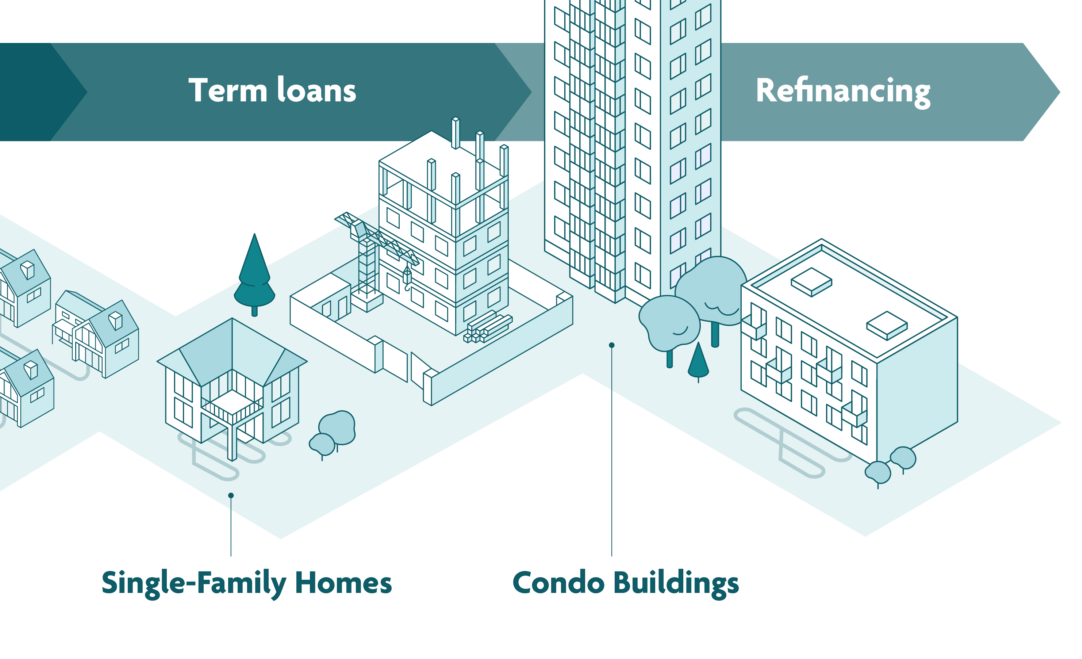This piece was originally produced for the Ontario Non-Profit Housing Association in January 2024
Affordable housing and climate change are top concerns for Canadians and, while they are often considered separate issues, the two are deeply intertwined. Retrofitted buildings, which incorporate energy-efficient upgrades into the existing building supply, can address both problems at once by offering significant opportunities to cut energy consumption, lower greenhouse gas emissions, and improve affordable housing conditions for Canadians.
Decarbonizing Ontario’s built environment is crucial for reaching Canada’s commitment of net-zero emissions by 2050, as our buildings contribute 24% of our national emissions — a marked increase of 42% since 19901. This situation is even more critical in urban areas like Toronto where buildings emit 58% of the city’s total emissions2.
VCIB specializes in financing climate sustainability and housing affordability. Our community-first finance model aims to contribute to the decarbonization of Canada’s building sector, while making substantial progress towards our net-zero by 2040 goal.
In 2022, we partnered with the City of Ottawa to support financing for the Better Homes Ottawa Loan Program, which allows residents to borrow funds for home energy improvement projects. The initiative is estimated to reduce individual household greenhouse gas emissions by 30% per year.

Understanding Retrofitting: A Sustainable Solution
Retrofit projects involve making rehabilitations, modifications, or upgrades to an existing building to improve its energy efficiency and reduce its ecological footprint.
Retrofits cover a wide spectrum, ranging from minor modifications such as upgrading lighting and appliances to major changes like replacing window glazing and doors. Then there are deep retrofits that involve an extensive overhaul of the entire building, which may include replacing the roof or swapping out older heating, cooling, and ventilation systems with renewable technology.
In the non-profit housing sector, common building retrofits include structural enhancements, energy efficiency improvements, accessibility upgrades, plumbing and electrical system enhancements, flood protection, earthquake resilience measures, and wildfire protection. As technology evolves, innovative solutions like geoexchange and micro-grids make retrofits the best path forward to reducing building emissions and advancing climate justice.
Energy Efficiency in Affordable Housing: A Wise Investment
Not only can retrofits reduce carbon emissions and protect a building from extreme weather, but upgrades can generate energy savings over time. Natural Resources Canada notes that deep retrofits can save up to 60% in energy costs, allowing for upfront costs to be recovered thanks to lower utility bills. Even more, retrofits can greatly enhance the comfort and desirability of homes for tenants and, ultimately, increase property values.
Overcoming Barriers to Retrofit Projects for Non-Profits
The burgeoning retrofit industry presents unprecedented opportunities for long-term sustainable housing.
“It’s vital that housing providers are able to make upgrades that allow them to continue to offer safe, comfortable and sustainable homes,” says Chloe Wong, a VCIB Commercial Real Estate Account Manager. “However, it can be a struggle for non-profit housing organizations to secure loans from traditional banks and lenders.”
Navigating this complex landscape requires committed partners like VCIB. Our experienced team at VCIB can help housing owners and operators understand what they need to do to prepare for a successful lending application and assist them in leveraging government grants and incentives whenever possible.
“We understand the sector’s retrofit needs and financing challenges,” adds Chloe. “We’re committed to putting in the extra effort to ensure non-profit housing providers get the retrofit financing they need.”
***
Learn more about VCIB’s social purpose real estate financing in our website. If interested in chatting with VCIB about your financing needs, get in touch.







